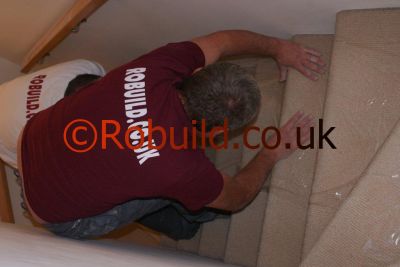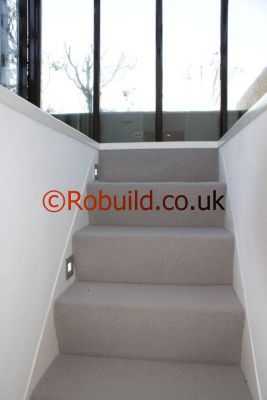
Your stair carpet receives more wear than you might expect, so make sure you buy the right type and fit it correctly, for safety and maximum economy. When selecting a carpet for stairs, bear in mind the heavy wear to which it is going to be subjected. Most people do not realize how many times even a small family use the stairs every day. Wear is not only caused by treading but also by the scraping of heels against the risers and by strong rubbing against the nosing. Long pile carpets (for example shag and semi-shag) are not suitable for staircases and foam-backed carpets are best avoided, if possible, since they are complicated to install. As in all carpet installations underlay is essential since it provides longer life, increases sound insulation and gives greater comfort. Don’t use stair pads, which only cover the tread area. When fitting underlay, make sure there is enough to pass round the nosing of the stair. To give longer life, a stair carpet should be moved about six months after laying; this enables those parts of the carpet covering the risers to be placed over the treads and vice versa. Subsequently, at longer intervals, the carpet should be slightly moved to equalize the wear. When the carpet is laid, the extra amount is folded against the riser at the bottom of the staircase. Before fitting the carpet, make sure the natural inclination of the pile faces downwards.

Measuring up
When buying a carpet, first measure the length you require. Assume the method of installation you are going to use will cause the carpet on the upper landing to overlap the top riser. Begin measuring from the base of the top riser and take the tape lightly over each tread and riser. Add to the total measured length an additional 38mm for each step to allow for the space taken by the underlay. Add a further 457mm to enable the carpet to be moved to increase its life. If the staircase includes a winder, measure along the path taken by the outer edge of the carpet.
Laying the carpet
The two main methods of laying stair carpets are by tacking down and by using tackless strip. Whichever method you use, it is necessary to mark on the stairs the positions of the edges of the carpet and the underlay; the marking for the underlay will also apply to the tackless strips when they are used. The purpose of this marking is to ensure the carpet is laid centrally when it is not wide enough to cover the stair fully. If the steps are 813mm wide and the carpet is 686mm wide, a mark should be made on the riser 63mm in from each edge. Then make a mark l9mm inside the first ones to indicate the width and position of the underlay and of the tackless strip.
Tack-down method
For tacking down a special type of tack is used which is less visible than the normal type. First attach all the underlay, using a separate piece for each step; the width should be 38mm less than the width of the carpet and it must be long enough to cover the tread and lap round the nosing so the lower edge can be secured to the riser below. Align the sides of each pad with the inner pair of marks and position the back edge 25mm in from the riser. Tack it down at intervals of 150mm across the back of the tread, stretch it over the nosing and tack it across the riser below. Starting at the top tread, position the end of the carpet as indicated by the marks so it is properly centred; allow an extra 13mm for turning under where the material reaches the top riser. Unwrap enough material from the roll to cover the first two or three steps. Before starting to tack, make sure the tuft rows across the carpet are parallel with the nosing. Turn the end of the carpet under so the cut end is not exposed and tack down one corner; stretch the carpet to make it even and
http://www.youtube.com/watch?v=n3MqTfu-JUw
tack across the riser at intervals of about 100mm. Continue down the stairs stretching the carpet over the nosing and tacking the edges in at the crotch- Then insert tacks across the crotch at 100mm intervals- Where additional material has been included to allow for fitting the material is folded in and held against the bottom riser by tacking up the sides. A slight overlap is needed at the bottom end of the carpet so it can be folded back when the carpet is finally tacked at the base of the lowest riser; take “his into amount also when measuring the shifting allowance- The same is done to the overlap of the landing carpet which covers the top riser.
Tackless strip method
Tackless strip is a flat narrow strip of wood, which is nailed to the floor; it is fitted with pins at an angle onto which the carpet is hooked- For laying stair carpets the strip is sold in 762mm lengths, so to fit a carpet 686mm wide cut the lengths down. When installing tackless strips, first mark the stairs as explained above, then fix the strips on the stairs. One strip is nailed across the riser, parallel with and 16mm above the crotch. Another strip is nailed across the tread the same distance from the crotch; this provides a gap into which the carpet is tucked- These distances will have to be increased or decreased according to the thickness of the carpet sine it is important to ensure a tight fit. The pins of both strips should lean towards the crotch. Next attach the pieces of underlay, which should be longer those used in the tack-down method. The rear edge of the underlay butts up against the tackless strip on the tread and is tacked down. Then front edge is taken over the nosing stretched down.
